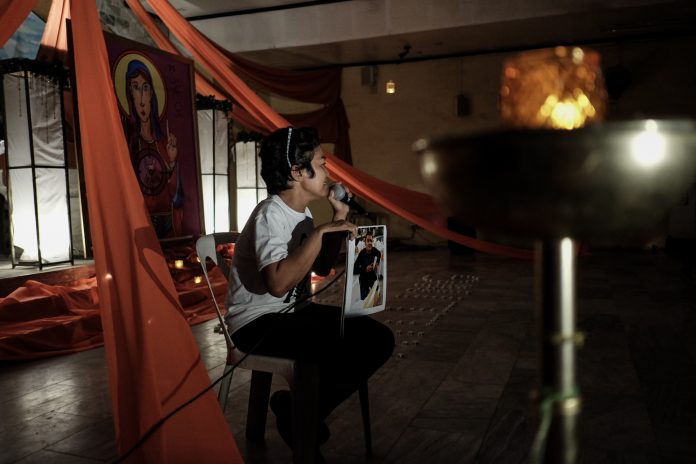In the gospel this Sunday, the disciples were afraid. They saw a “ghost” walking towards them. When you are in the midst of a storm and the winds and waves have been battering you from all sides, there could be “ghosts” all over — both real and imagined.
“It is I. Do not be afraid,” Jesus assured them. The phrase — “It is I” — is actually an echo of the words “I am” (Ego eimi, ἐγώ εἰμι) when God introduced who God is to Moses in Mount Sinai (Ex. 3: 14).
Para bang sinasabi ni Jesus: “Ako ‘to. Kasama mo ako sa gitna ng unos. Manalig ka. Wala kang dapat ikabahala. Wala kang dapat ikabahala.”
Peter dared him: “To prove that it is really you, let me walk on the water.” But the winds were still strong and Peter faltered. His weak faith did not sustain him in the midst of the strong wind.
Unlike Peter, there were many others — most of them women — who dared to walk but did not sink in the waters despite the storm. Their faith sustained them.
I was recently invited to watch the documentary — “Maria” — at Cinemalaya Films directed by a good friend, Sheryl Andes. [This is not a film review. This is my contextual reading of the gospel through the film.]
The movie is about three women who dared to walk on the water but did not sink despite the storm. Instead of seeing a “ghost” (and there were many around them), it was God that strengthened them. The three “Marias” shows the other side of the gospel. While Peter sank, the Marias walk through the storm and continues to navigate through a hard life.
The film — the only documentary film in this year’s Cinemalaya —described to us the real storm we went through in the last six years of the Duterte regime. Violence, killing, pain, and desperate shouts for help from widows and orphans were like strong winds sweeping through our land.
The first Maria had her first son killed through a police operation during the “war on drugs”. Her second son was discovered floating on the waters while she was still mourning the wake of her first son. This is the experience of Pieta twice over.
Then the 2022 election campaign came. Like the rest of her friends, they were drawn into the BBM (Bongbong Marcos) campaigns. She went to these rallies maybe hoping for some “blessings”.
When the candidates were speaking, one of them the daughter of the President who killed her sons, the director painfully captured the pain in Maria’s face. And as she received the ashes of her sons in another activity, she promised to fight for justice for them till the end.
The second “Maria” is Maria Leonor (Leni) Robredo, another widow. Her story is well documented. She challenged the storm and was “defeated” or “cheated” in the elections, depending on which vantage point you see it.
But she won the hearts of many and the hope stays there forever. I remember one of scenes when she said: “Namatayan din ako ng asawa ko. Pero sa aksidente. Mas grabe ang nararanasan ninyo. Pinatay sila ng mga taong dapat nag-protekta sa kanila.” What a deep and humble sense of solidarity!
The third Maria is “Mary Ann”. The armed men came into her house one night while they were sleeping, pointed a gun at them, and killed her husband point blank. Her son was supposed to be saved but since he defended his father, he was also killed.
She left that place upon the advice of her relatives and friends. But she said she wants to go back there. It is there that her memories were — the memories of her loved ones.
Today, Mary Ann starts a small business with her family, just finished high school through the Alternative Learning System (ALS) program, and is in Senior High School. I talked to her very young classmates after the movie. They were there to support her. Mary Ann wants to pursue higher education and dreams to be a counselor to EJK (extrajudicial killing) victims one day.
There were other “Marias” outside the script. The forensic pathologist, Dr. Racquel Fortun, despite the danger continues to keep on her work to make the cadavers “tell the truth of what happened to them”.
During the storm, practicing one’s science can be dangerous. Second, is the group “Paghilom” under Fr. Flavie Villanueva, SVD. Paghilom is a group of EJK widows who have become a source of hope for one another. Instead of walking alone, these victims walk together in the storm.
The last is the filmmaker herself. She Andes says in an interview: “We have to register that this thing really happened. And now people need to see what has happened to their families… It is a story about women.” If I may add: “women who dared the storm”.
Instead of seeing ghosts, these Marias just keep on treading the storm. The winds and the waves are really strong. But they did not see “ghosts” — even as there were real gun-totting ghosts that roamed around their streets and entered their houses. They are surely in pain. Maybe they are also afraid.
But they trust in the God who said “It’s me. I am with you.”
Gospel reflection: Matthew 14: 22-33
Father Daniel Franklin Pilario, C.M., is a theologian, professor, and pastor of an urban poor community on the outskirts of the Philippine capital. He is also Vincentian Chair for Social Justice at St. John’s University in New York. The opinions and views expressed in this article are those of the authors. They do not purport to reflect the opinions or views of LiCAS News or its publishers.









